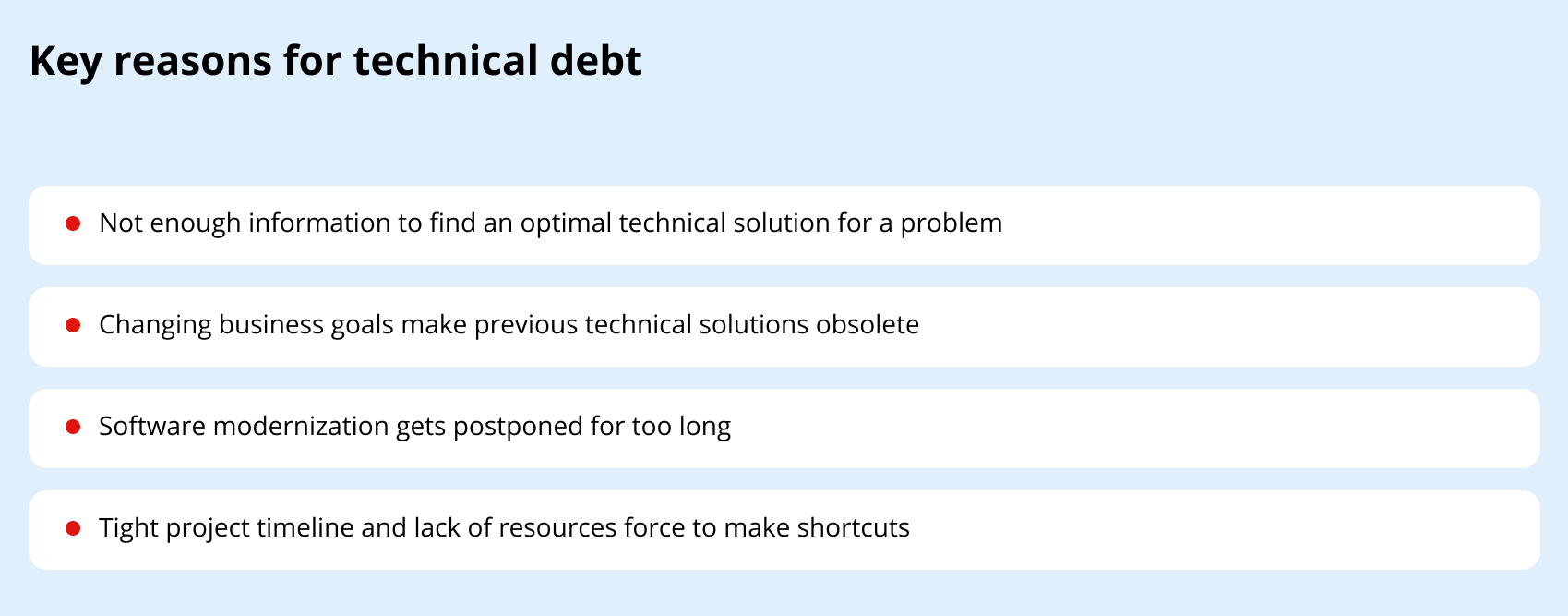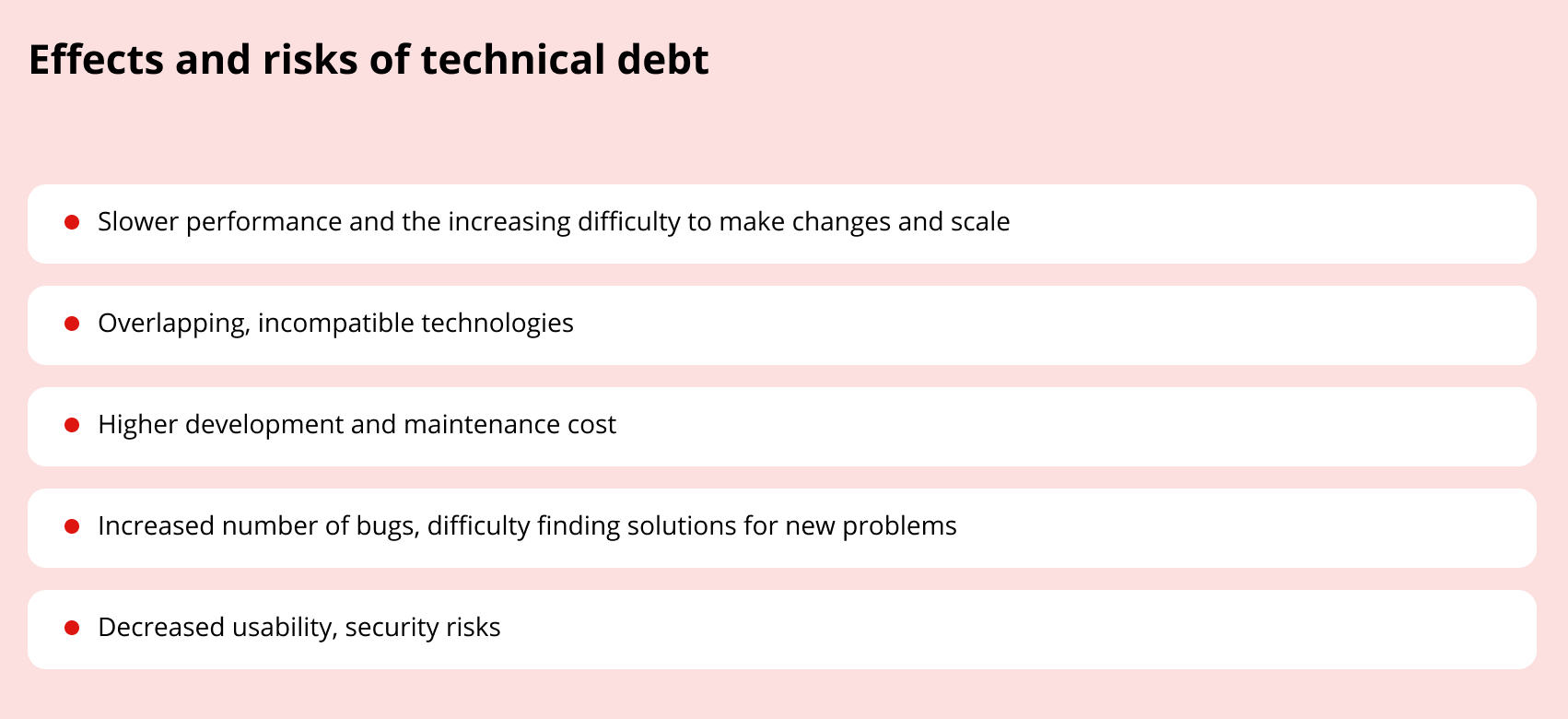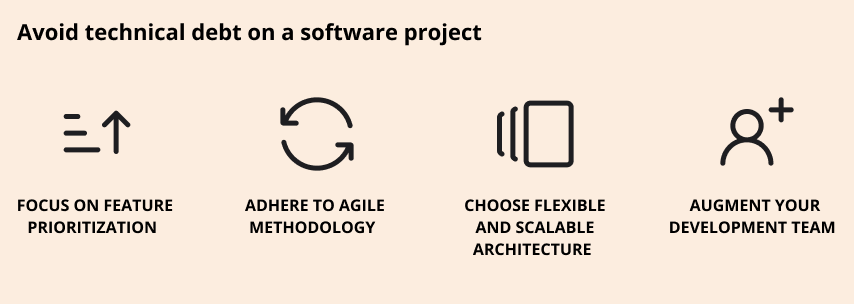Technical Debt Reduction: 5-Step Plan to Cut and Avoid Tech Debt
Technical debt is a common issue in software development that appears for different reasons. It can transform into a costly problem if ignored and unaddressed. To make sure it won’t happen, business and tech executives adopt smart and efficient strategies for technical debt reduction.
If you are looking for ways to understand and manage technical debt on your project, read on – this post will come in handy. We will answer major questions about tech debt and ways to reduce and avoid it.
- What is technical debt and how to identify it?
- What are the key reasons for growing technical debt and how it affects a software project?
- How to reduce existing technical debt and prevent new debt from emerging?
- Where to find help to develop an effective technical debt reduction plan?
Technical debt is the delayed development work that was set aside, often on purpose, to speed up software project delivery. Companies may accept that they have to accumulate some technical debt to achieve certain business objectives, e.g., meet a tight deadline or roll the product out as fast as possible to outrun competitors. One of the most frequent causes of technical debt is the need to get the system out in the field to better understand how to solve a given problem and get the missing information needed to design and develop a better product.
Technical debt in software engineering often refers to choosing a good working solution over a perfect one to save time or resources. For the time being, this solution reflects current business goals and can later be polished, amended, or improved.
Technical debt, however, has nothing to do with poor coding. Bad code is never an option.
Key causes of technical debt

As we mentioned before, there are many reasons why technical debt may appear. While some companies deliberately opt for some debt as a tradeoff for faster delivery, others have to deal with unintentional debt caused by changing market reality and business goals.
Insufficient information
Design or development teams may have not enough information to find an optimal technical solution for a problem. In this case, they choose a temporary working solution to win time, gather user feedback and other insights necessary to work out a better solution or technical approach.
Changing business goals
It’s not unusual for business goals to change halfway through a software development project. This may shake up priorities, add new requirements or even modify the overall product strategy. As a result, previous technical solutions may become obsolete and create technical debt.
Technology evolution
Technologies evolve now faster than ever before. When software modernization gets postponed for too long, it may end up with emerging and growing technical debt. Not to mention the risks deteriorating performance or a major technical breakdown.
Tight deadline, limited resources
One of the key causes of technical debt is a tight project deadline that forces a development team to take shortcuts to deliver on time.
Depending on the cause of debt, it may pose different risks for a software project.
Effects and risks of technical debt

Just like financial debt, technical debt must be paid off in time and as planned (if it was intentional). Otherwise, it may build up and create a domino effect making it harder to keep track and deal with it later. Among the common risks associated with ignored or mismanaged tech debt are:
- Slower performance and the increasing difficulty to make changes and scale
- Overlapping, incompatible technologies
- Higher development and maintenance cost
- Increased number of bugs, difficulty finding solutions for new problems
- Decreased usability, security risks
The longer the debt is unaddressed, the higher the interest is – the difficulty and cost of dealing with the development work that was put off. To prevent the debt from eating up the resources that could otherwise be used to further develop the system, we recommend an effective approach to technical debt reduction.
Here are 5 essential steps to keep technical debt under control and make sure it is paid off in time and with minimum investment.

Step 1. Acknowledge and understand debt
Effective technical debt reduction strategy starts with acknowledging the debt and understanding its source. At this step, you need to figure out how the debt occurred in the first place.
Was it planned or unintentional? Was it caused by changing scope, project goals, the evolution of technologies? Could it be avoided? Answering these questions will help you understand the nature of your debt and determine how you can reduce technical debt later on.
Step 2. Evaluate and measure
Depending on the causes and effects of technical debt, you may use different factors and techniques to analyze and measure it.
Technical debt may decrease the speed of development (e.g. because of the growing code complexity), so analyzing the amount of work done from iteration to iteration may show the impact of tech debt on team performance. In other cases, teams may use analytics tools that monitor system performance to track down the problems and see how these problems correlate with the technical decisions that caused the debt.
After having the debt evaluated and measured, you can assess the risks and make the cost-benefit analysis.
Step 3. Communicate and deliver cost-benefit
Technical debt assessment is important for both tech executives and non-tech decision-makers in the organization.
First of all, because it gives better visibility and allows to communicate the problem. It often helps to put a price tag on a problem to show how it may affect the project and explain why paying a debt in time is important.
Secondly, clear cost-benefit analysis helps to better prioritize and plan the payment strategy.
Step 4. Schedule regular and frequent pay-off
How to reduce technical debt without compromising the ongoing progress? One of the most efficient strategies is to divide the scope of the extra work into smaller milestones and gradually pay it off by integrating it into the normal workflow. This approach helps the team stay on top of the technical debt and make sure it’s getting smaller over time.
Don't let technical debt get out of hands
Get rid of tech debt with an actionable plan integrated into your roadmap and aligned with your budget.
TALK TO TECH EXPERTSStep 5. Introduce practices to minimize/avoid tech debt
This is the last step of the technical debt reduction strategy. However, we recommend introducing engineering and coding practices that help minimize and avoid tech debt entirely as early as possible.
- Develop and maintain a solid testing strategy to avoid bugs or imperfections from piling up.
- Measure and monitor code quality and complexity to make sure it’s reusable and understandable.
- Keep track of the technical debt and maintain a record of all the work done to reduce the debt.
- Opt for smart requirements prioritization and an agile development approach to minimize the chance to accumulate any tech debt.
Let’s look into these practices in more detail and see how they can support your efforts in minimizing technical debt or staying away from it entirely.

Focus on requirements prioritization
Sound requirements prioritization is a proven way to avoid unnecessary technical debt. Using different techniques for requirements prioritization, project managers work out the scope and development strategy that reflects given business goals and timelines.
Often it means that only essential functionality gets to the original scope, while the rest of the features are developed after the first version of the product is out. It allows the team to focus on well-balanced MVP development without the need to take shortcuts to meet tight deadlines.
Adhere to agile methodology
One of the most flexible approaches to software development, agile methodology also works as an effective technical debt reduction technique. The idea of iterative development sits well with the incremental approach to the reduction of technical debt. Teams that work in an agile environment manage to keep it under control by continuously reducing technical debt, iteration by iteration.
Moreover, agile methodology provides the flexibility and testability needed to avoid technical debt in the first place.
Choose flexible and scalable architecture
Flexible microservices-based architecture helps developers create scalable software. Dividing a system into small functional components provides better stability, maintainability and security and makes it easier for engineers to support and upgrade the system. That, in turn, helps to avoid technical debt related to delayed software modernization.
Start with microservices consulting to better understand how to leverage this approach on your project and extract real benefits for your business.
Augment your development team
How to avoid technical debt which occurs due to a lack of time or resources? Team augmentation is a viable strategy for companies that can’t meet tight deadlines. Instead of cutting corners to keep up with the delivery schedule, add extra talent to your in-house team and focus on achieving your business goals without risks.
You already know that technical debt can be deliberate and unintentional. Common examples of unintentional tech debt include:
- Suboptimal choice of technologies, approaches, or practices due to a lack of information or understanding of how to build a certain feature or functionality.
- Low readability and testability of code due to inconsistent coding principles, lack of engineering practices and standardization, or significant changes on the project such as high rotation among engineers.
- Aging technologies that require upgrade which is overlooked due to low business priority.
- Underestimated complexity of technologies or solutions.
Deliberate technical debt is a decision. It is often the result of a well-thought strategy to meet a tight deadline or help a business reach a certain goal.
One of the examples of a deliberate technical debt in our practice was an accelerated migration of complex photo editing applications from aging Flash Player to HTML5 for one of our long-standing clients. The project had a very tight deadline caused by cascading announcements to discontinue Flash support on all major browsers.
Challenges
- Full-scale migration of business-critical web applications to HTML5 within a tight time frame.
- Work against lacking best practices and trailblaze the path for effective implementation.
- Ensure seamless migration of business-critical applications that won’t affect the client’s operations and ensure reliability and efficiency of online services.
Solution
- Plan and implement migration in a short time to enable the client’s business continuity and transition to a future-ready tech stack.
- Log all compromises during accelerated migration and possible improvements for future iterations.
- Gather feedback and data on performance, scalability, and other important factors.
- Plan and implement gradual upgrades based on gathered data, prioritized business requirements, and emerging best practices.
Result
In this case, technical debt was a result of a calculated approach that enabled cost-effective, fast and seamless migration. After the first iteration, we released the upgraded version of the applications, leveraging the benefits of reducing technical debt incrementally.
Effective transition to new technology helped the client secure its leadership in the niche. Today, the company runs one of the most advanced online services for photo printing, providing an excellent experience to millions of B2B and B2C customers in the US and winning countless awards for web services.

Are you looking for a reliable and experienced technology partner who could help you manage technical debt on your project? Contact our team and request a consultation.
For more than a decade in software development and consulting, we have been working with different projects (fast-evolving startup products, enterprise-level cloud, scalable SaaS, etc.) and diverse technologies (.NET, Java, Node.js, Python, Angular, React, and more). We can help you understand the source of your problem, develop an effective approach to technical debt reduction and integrate effective practices to avoid technical debt entirely.
Eliminate technical debt, effectively and risk-free
Hire senior tech experts to analyze, manage and eliminate tech debt that hinders your business growth.
HIRE TECH EXPERTSTechnical debt occurs for different reasons and can be deliberate, unintentional and unavoidable. Effective engineering and project management practices help effectively reduce and keep it under control. It involves acknowledging, evaluating and communicating technical debt followed by the gradual continuous pay-off in small parts.
This post was originally published on December 7, 2021 and updated on July 25, 2023.
FAQ
- Acknowledge that it exists
- Understand and evaluate technical debt
- Communicate the problem to stakeholders
- Develop a strategy to gradually reduce tech debt
- Integrate practices that help avoid or minimize tech debt







